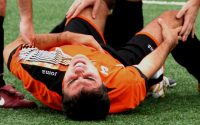The Impact of Percussive Therapy Using Massage Guns on Physiological Adaptations and Musculoskeletal Pain
Percussive therapy has gained popularity as a non-invasive method for enhancing muscle function and reducing musculoskeletal pain. However, specific research on the effects of percussive therapy delivered by massage guns remains limited.
A systematic literature review by researcher from The Open University, published in International Journal of Sports Physical Therapy, aims to provide insights into the impact of
percussive therapy on physiological adaptations and musculoskeletal pain, shedding light on its potential benefits in strength and conditioning settings.
The review searched for studies published from January 2006 onwards, retrieved from scientific databases. Thirteen studies were included in the review, all of which demonstrated methodological limitations but provided valuable insights.
The findings revealed several notable effects of percussive therapy delivered by massage guns:
- Muscle Strength: While limited in number, some studies reported a positive effect on upper body muscle strength. However, the evidence was based on subjective strength assessment methods, raising questions about reliability. Similar findings were observed in previous research on localized vibration’s impact on muscle strength.
- Explosive Muscle Strength:
Percussive therapy was found to promote an increase in explosive muscle strength in multiple studies, supporting the idea that local vibration can lead to beneficial changes. However, conflicting results were noted in studies on explosive power. - Flexibility: Several studies reported increased flexibility following
percussive therapy, but no significant difference was observed when compared to traditional static stretching. This suggests that
percussive therapy’s impact on flexibility may not be unique, and previous research on vibration treatments yielded similar results. - Experiences of Pain: Multiple treatments of
percussive therapy were associated with reduced musculoskeletal pain. This aligns with a recent meta-analysis, which showed that vibration interventions effectively reduced delayed-onset muscle soreness (DOMS) at various time points. - Pain vs. Flexibility: Some studies suggested that improvements in flexibility resulting from percussive therapy were linked to pain reduction, indicating a potential connection between the two outcomes.
Mechanisms: The review also discussed potential mechanisms underlying the positive effects of percussive therapy. When percussive therapy is applied to the muscle belly or tendon, it activates muscle fibers and induces a tonic vibration reflex, which may trigger an analgesic effect according to the gate control theory of pain. Additionally, percussive therapy may promote increased metabolic activity within muscles, including enhanced blood flow, oxygen saturation, and temperature, contributing to the observed physiological adaptations.
Conclusion: Percussive therapy delivered by massage guns has shown promise in enhancing muscle strength, explosive muscle strength, flexibility, and reducing musculoskeletal pain. Despite methodological limitations in existing studies, these devices offer a portable and cost-effective alternative for achieving these outcomes. Further research is warranted to establish optimal protocols and refine our understanding of the mechanisms.

